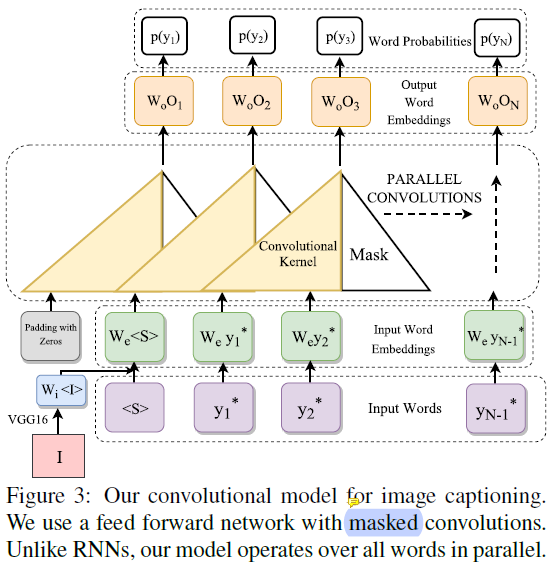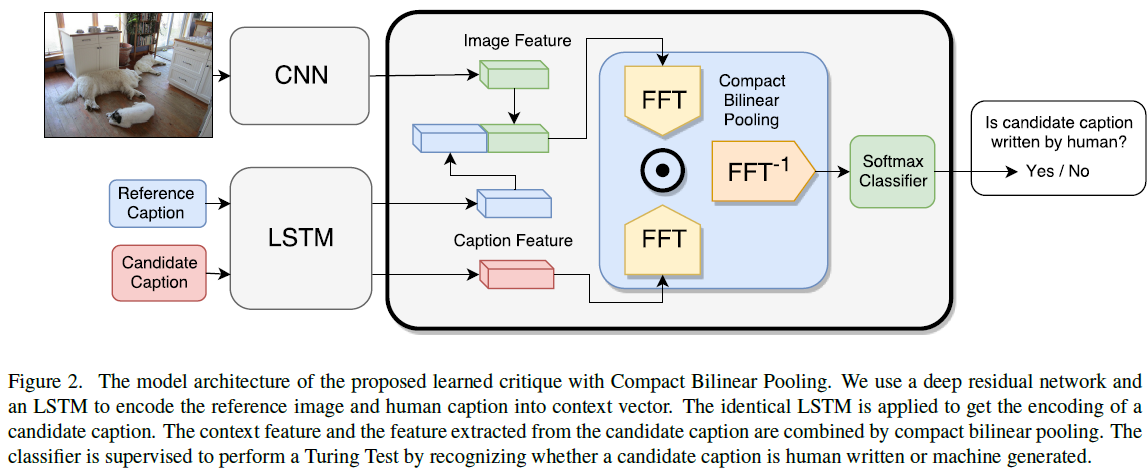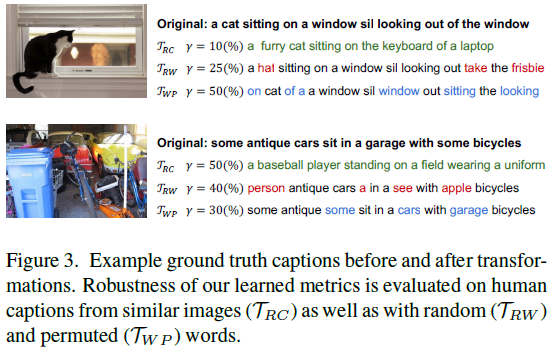Paper Reading - Learning to Evaluate Image Captioning ( CVPR 2018 ) ★
Link of the Paper: https://arxiv.org/abs/1806.06422
Innovations:
- The authors propose a novel learning based discriminative evaluation metric that is directly trained to distinguish between human and machine-generated captions. They train an automatic critique to distinguish generated captions from human-written ones, and then score candidate captions by how successful they are in fooling the critique. Formally, given a critique parametrized by Θ, a reference image i, and a generated caption c, the score is defined as the probability for the caption of being human-written, as assigned by the critique: scoreΘ(c, i) = P(c is human written | i, Θ). More generally, the reference image represents the context in which the generated caption is evaluated. To provide further information about the relevance and salience of the image content, a reference caption can additionally be supplied to the context. Let C(i) denotes the context of image i, then reference caption c could be included as part of context, i.e. c∈C(i). The score with context becomes scoreΘ(c, i) = P(c is human written | C(i), Θ).


- To systematically create pathological sentences, the authors define several transformations to generate unnatural sentences that might get high scores in an evaluation metric. Their proposed data augmentation scheme uses these transformations to generate large number of negative examples. Formally, a transformation Τ takes an image-caption dataset and generates a new one: Τ({(c, i) ∈ D}; γ) = {(c1', i1'), ..., (cn', in')}, where i, ii' are images, c, ci' are captions, D is a list of caption-image tuples representing the original dataset, and γ is a hyper-parameter that controls the strength of the transformation. Specifically, authors define following three transformations to generate pathological image-captions pairs:
- Random Captions ( RC ): To ensure the metric pays attention to the image content, they randomly sample human written captions from other images in the training set: TRC(D; γ) = {(c', i) | (c, i), (c', i') ∈ D, i'∈Nγ(i)}, where Nγ(i) represents the set of images that are top γ percent nearest neighbors to image i.
- Word Permutation ( WP ): To make sure that their metric pays attention to sentence structure, authors randomly permute at least 2 words in the reference caption: TWP(D; γ) = {(c', i) | (c, i) ∈ D, c' ∈ Pγ(c) \ {c}}, where Pγ(c) represents all sentences generated by permuting γ percent of words in caption c.
- Random Word ( RW ): To explore rare words authors replace from 2 to all words of the reference caption with random words from the vocabulary: TRW(D; γ) = {(c', i) | (c, i) ∈ D, c' ∈ Wγ(c) \ {c}}, where Wγ(c) represents all sentences generated by randomly replacing γ percent words from caption c.

- The authors propose a systematic approach to measure the robustness of an evaluation metric to a given pathological transformation.
General Points:
- Commonly used evaluation metrics for Image Captioning: BLEU, METEOR, ROUGE, CIDEr, SPICE. These metrics face two challenges. Firstly, many metrics fail to correlate well with human judgments. Metrics based on measuring word overlap between candidate and reference captions find it difficult to capture semantic meaning of a sentence, therefore often lead to bad correlation with human judgments. Secondly, each evaluation metric has its well-known blind spot, and rule-based metrics are often inflexible to be responsive to new pathological cases.
- Compact Bilinear Pooling ( CBP ) has been demonstrated in Multimodal compact bilinear pooling for visual question answering and visual grounding to be very effective in combining heterogeneous information of image and text.
Paper Reading - Learning to Evaluate Image Captioning ( CVPR 2018 ) ★的更多相关文章
- Paper Reading - Convolutional Image Captioning ( CVPR 2018 )
Link of the Paper: https://arxiv.org/abs/1711.09151 Motivation: LSTM units are complex and inherentl ...
- Paper Reading - Learning like a Child: Fast Novel Visual Concept Learning from Sentence Descriptions of Images ( ICCV 2015 )
Link of the Paper: https://arxiv.org/pdf/1504.06692.pdf Innovations: The authors propose the Novel V ...
- Paper Reading: Stereo DSO
开篇第一篇就写一个paper reading吧,用markdown+vim写东西切换中英文挺麻烦的,有些就偷懒都用英文写了. Stereo DSO: Large-Scale Direct Sparse ...
- 读paper笔记[Learning to rank]
读paper笔记[Learning to rank] by Jiawang 选读paper: [1] Ranking by calibrated AdaBoost, R. Busa-Fekete, B ...
- 在矩池云上复现 CVPR 2018 LearningToCompare_FSL 环境
这是 CVPR 2018 的一篇少样本学习论文:Learning to Compare: Relation Network for Few-Shot Learning 源码地址:https://git ...
- 爬取CVPR 2018过程中遇到的坑
爬取 CVPR 2018 过程中遇到的坑 使用语言及模块 语言: Python 3.6.6 模块: re requests lxml bs4 过程 一开始都挺顺利的,先获取到所有文章的链接再逐个爬取获 ...
- Paper Reading - Convolutional Sequence to Sequence Learning ( CoRR 2017 ) ★
Link of the Paper: https://arxiv.org/abs/1705.03122 Motivation: Compared to recurrent layers, convol ...
- Paper Reading - Deep Captioning with Multimodal Recurrent Neural Networks ( m-RNN ) ( ICLR 2015 ) ★
Link of the Paper: https://arxiv.org/pdf/1412.6632.pdf Main Points: The authors propose a multimodal ...
- Paper Reading - Deep Visual-Semantic Alignments for Generating Image Descriptions ( CVPR 2015 )
Link of the Paper: https://arxiv.org/abs/1412.2306 Main Points: An Alignment Model: Convolutional Ne ...
随机推荐
- JQuery手写一个简单的分页
效果图: 大概思路:使用ul进行初始布局,每一次点击事件改变li里的值.完整的代码在gitup上:https://github.com/anxizhihai/Paging.gitcss部分: html ...
- django模板中如何导入js、css等外部文件
本教程只适合Django1.4版本.(1.8版本之后不需要这么麻烦,详见 http://www.cnblogs.com/ryan255/p/5465608.html) html模板里面使用了css,但 ...
- python 输入三个整数,按照从小到大的顺序打印
# # 3 输入三个整数,按照从小到大的顺序打印 a = int(input('请输入第一个整数:')) b = int(input('请输入第二个整数:')) c = int(input('请输入第 ...
- c#聊聊文件数据库kv
现在有很多KV嵌入式存储,或者已经增加的.leveldb,RaptorDB等,都是相对比较好的存储.基本存储,一般配置.大概在6w/s左右.当然还有缓存等设置问题.这些基本是字符串和int的存储,对于 ...
- 如何创建systemd定时任务
1. 如何创建一个定时任务,通过systemd系统 1. 如何创建一个定时任务,通过systemd系统 1.1. systemd中的timer 1.2. 自定义定时任务 1.2.1. 具体步骤 1.2 ...
- Django学习笔记2
1.BookInfo.objects.all() objects:是Manager类型的对象,用于与数据库进行交互 当定义模型类时没有指定管理器,则Django会为模型类提供一个名为objects的管 ...
- 微信小程序调用api接口
请求的第三方微信url大概有3种 1)$url = "https://api.weixin.qq.com/sns/oauth2/access_token?appid=$appid&s ...
- Ldap实现AD域认证
1.java Ldap基础类 package com.common; import java.io.FileInputStream; import java.io.IOException; impor ...
- Python文本和字符串常用操作
## 字符串分割 line = "This is my love!" fields = line.split(' ') print(fields) # ['This', 'is', ...
- Python系列之入门篇——pytables及其客户端
pytables及其客户端查看 pytables # ubuntu sudo apt-get install python-tables pip install flask flask-httpaut ...
